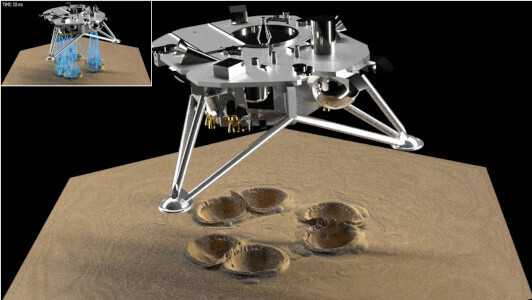(Huntsville, Ala. | September 9, 2021) – CFD Research was recently awarded a contract to develop an integrated approach to combine measurement and modeling methodologies to further improve the accuracy of the gas granular flow solvers used by NASA for analysis and design of lander plume-surface interactions. CFD Research is leading a team including the University of Michigan and Johns Hopkins University.
 “The liberation of dust and debris particles caused by rocket plume flow from spacecraft landing on the unprepared regolith of the Moon, Mars, and other extra-terrestrial destinations poses a high risk for robotic and human exploration activities,” said Dr. Ranjan Mehta, CFD Research director and project manager for the effort. “Regolith debris is lofted from the surface by the gas flow and accelerated to high velocities with kinetic energy levels that pose a threat to the vehicle itself and any nearby sensitive objects.”
“The liberation of dust and debris particles caused by rocket plume flow from spacecraft landing on the unprepared regolith of the Moon, Mars, and other extra-terrestrial destinations poses a high risk for robotic and human exploration activities,” said Dr. Ranjan Mehta, CFD Research director and project manager for the effort. “Regolith debris is lofted from the surface by the gas flow and accelerated to high velocities with kinetic energy levels that pose a threat to the vehicle itself and any nearby sensitive objects.”
The lunar regolith, as the extreme example, is poorly sorted with broad particle size distributions and large fines content, and gravel and cobbles embedded in the soil. It has significant cohesion, due to interlocking particle shapes for the very jagged particles. It is essential to develop the capability to model the response of such poly-disperse granular materials consisting of irregular shaped particles, especially in relevant “extreme” conditions. The combination of particle shape and size distribution has been identified as major drivers in the complex particle flow response of the extra-terrestrial granular material.
“Lander plume-surface interaction modeling is a clearly identified gap in Entry, Descent and Landing (EDL) analysis capability requirements in the NASA Technology Roadmap,” noted Sami Habchi, CFD Research executive vice-president. “The complex nature of the physics involved and the lack of experimental data requires the dedicated effort towards modeling and validation that will be performed under this project.”
CFD Research developed the Gas-Granular Flow Solver (GGFS) through several NASA SBIR/STTR projects and implements an Eulerian-Eulerian two-fluid approach which has become the most mature NASA plume-surface interaction simulation tool.
About CFD Research: Since its inception in 1987, CFD Research has worked with government agencies, businesses and academia to provide innovative solutions within the Aerospace & Defense, Biomedical & Life Sciences, and Energy & Materials industries. Over the years CFD Research has earned multiple national awards for successful application and commercialization of innovative technology prototypes, multi-physics simulation software, multi-disciplinary analyses, and expert support services. CFD Research’s impressive three-year growth rate was high enough to recognize the company in the Inc. Magazine’s 5000 for the second year in a row. CFD Research is an ISO9001 and AS9100 registered company and is appraised at CMMI Level II for services. Learn more at www.cfd-research.com.






